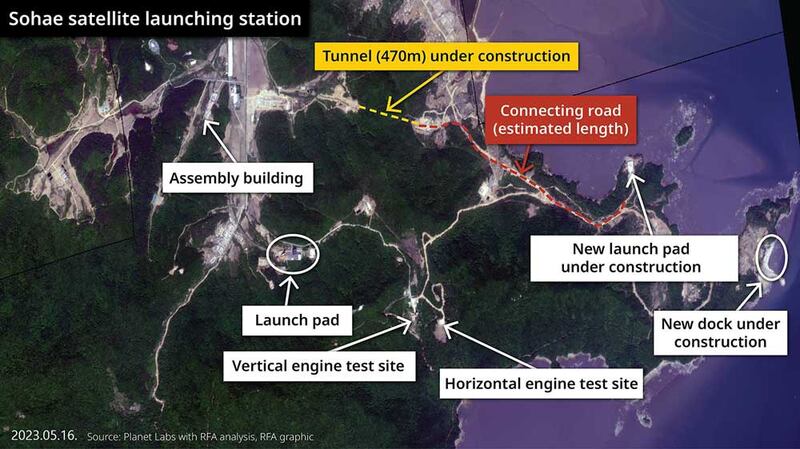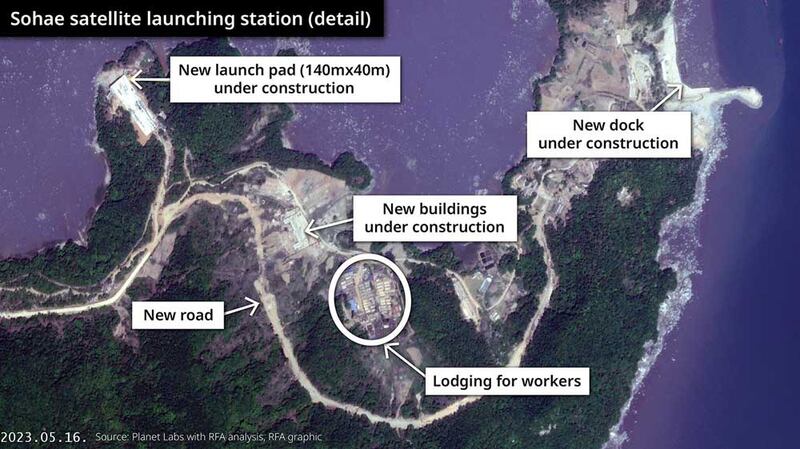North Korea is preparing to launch a spy satellite that it claims will bolster its defensive capabilities, state media reported, boasting that its launch would be “ a clear stride forward” in military science and technological development.
Satellite imagery of the likely launch site of a rocket that would put it into orbit suggests that it will be ready in June at the earliest, experts told Radio Free Asia.
The state-run Korean Central News Agency, or KCNA, reported that Kim Jong Un inspected the preparatory committee for the satellite launch on Tuesday.
“The more desperately the U.S. imperialists and south Korean puppet villains escalate their confrontational moves against the DPRK, the more fairly, squarely and offensively the DPRK will exercise its sovereignty and just right to self-defense to deter them and defend the country,” the agency reported Kim as saying, using the acronym for the Democratic People’s Republic of Korea. (KCNA deliberately does not capitalize the word “south” in “South Korea” on its English website.)
The news of Pyongyang’s military satellite plans comes just weeks after a summit between South Korea’s President Yoon Suk Yeol and U.S. President Joe Biden, where the two sides agreed to increase security cooperation and reaffirmed their commitment to extended deterrence in response to the North Korean nuclear threat.
KCNA reported that the satellite was ready for mounting after it passed an assembly inspection and tests for its durability in the vacuum of space.
Pyongyang, we have a problem
Although the report said Kim had approved the “future action plan” of the preparatory committee, which suggests that a launch is imminent, the launch site is not quite ready for a rocket that would be able to put it in Earth’s orbit, satellite imagery revealed.
The Sohae Satellite Launching Station, located in Tongchang-ri on the country’s northwestern coast, is currently under construction.
Though the station has an existing launch site, images from U.S. imaging firm Planet Labs showed work on a 470-meter (510-yard) tunnel and a road that would connect the old site with a new launch site, and a pier.
Also visible are new buildings, a new launch pad, and accommodations for construction workers.

The images indicate that construction is accelerating there: exposed soil on an April 30 image gives way to a finished concrete surface on May 16, and a box-shaped structure replaces a flat surface in about the same period of time.
In addition, movements presumed to be related to launch preparations have been observed in images of the launch site.
Based on the imagery, a launch won’t be possible until June or July, Bruce Songhak Chung, a researcher at the South Korea-based Korean Institute for Security and Strategy, told RFA’s Korean Service.
Chung, who often analyzes satellite imagery of North Korea as part of his research, said that the boxlike structure has a role in the process of loading the satellite onto a rocket.
“Even if you mount a satellite, there's a lot of fuel injection and other work to do. It doesn't look like it’s at that phase yet,” he said. “We have to wait and see.”.
TEL launch
There is also a possibility that the satellite could be launched from the back of a TEL (transporter erector launcher) truck, said Martyn Williams, a senior fellow at the Washington-based Stimson Center.
“They could do a TEL launch at any time,” said Williams. “But we think they are going to use Sohae. In that case it will not be this week.

Pictures of a model of the satellite released by KCNA indicate that it would allow Pyongyang to take images comparable to those of commercial imagery firms, Joseph S. Bermudez, a senior fellow at the Washington-based Center for Strategic and International Studies, told RFA. Most commercial satellite imagery has a resolution of between 2 and 5 meters.
“I guess [the satellite] seems about 60 centimeters by 60 centimeters by 80 centimeters and from 75 to 100 kg,” said Bermudez. “It seems very similar to Planet Labs'. … If it's successful and 'there's a big if', it should probably have a resolution of less than 3 meters."
Translated by Claire Shinyoung Oh Lee. Written in English by Eugene Whong. Edited by Malcolm Foster.
